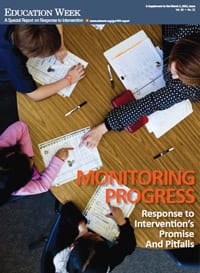 Response to Intervention (RTI) has become a
buzzword in both general education and special education circles—yet
understanding of the approach remains superficial. Enter this EdWeek special report, which serves as a
solid primer on what RTI is, why it’s used, and what some of its common
pitfalls are. As articulated in the series of articles, RTI is an instructional
technique that educators use to assist students with academic or behavioral
problems; it entails providing these students with tiered and increasingly
intensive instruction to address problems in their infancy. RTI first appeared
on the scene as a special education diagnostic tool, and is now utilized in the
gen ed setting as a preventive measure for a host of potential student hang-ups,
both academic and behavioral. Yet despite the popularity of RTI, obstacles
remain: Few education schools adequately prepare teachers to effectively use
RTI, and some parents have reported that RTI led to unnecessary delay in
special education identification. Further, RTI’s fluidity can cause districts
ire, as appropriately doling out funding for the effort (often between Title I
and special education coffers) gets awkward. In the end, though, the greatest
obstacle facing RTI is the dearth of research conducted on the topic. The
report notes that, while RTI has gained many advocates, no rigorous study of
the entire RTI model has ever been conducted. And though special education
numbers have decreased as RTI has expanded its reach, a definitive link between
the two has yet to be proven. Though many agree that an RTI-like approach is
simply good teaching, we won’t know how
good for some time yet.
Response to Intervention (RTI) has become a
buzzword in both general education and special education circles—yet
understanding of the approach remains superficial. Enter this EdWeek special report, which serves as a
solid primer on what RTI is, why it’s used, and what some of its common
pitfalls are. As articulated in the series of articles, RTI is an instructional
technique that educators use to assist students with academic or behavioral
problems; it entails providing these students with tiered and increasingly
intensive instruction to address problems in their infancy. RTI first appeared
on the scene as a special education diagnostic tool, and is now utilized in the
gen ed setting as a preventive measure for a host of potential student hang-ups,
both academic and behavioral. Yet despite the popularity of RTI, obstacles
remain: Few education schools adequately prepare teachers to effectively use
RTI, and some parents have reported that RTI led to unnecessary delay in
special education identification. Further, RTI’s fluidity can cause districts
ire, as appropriately doling out funding for the effort (often between Title I
and special education coffers) gets awkward. In the end, though, the greatest
obstacle facing RTI is the dearth of research conducted on the topic. The
report notes that, while RTI has gained many advocates, no rigorous study of
the entire RTI model has ever been conducted. And though special education
numbers have decreased as RTI has expanded its reach, a definitive link between
the two has yet to be proven. Though many agree that an RTI-like approach is
simply good teaching, we won’t know how
good for some time yet.
|
Education Week, “Monitoring Progress: Response to Intervention’s Promise and Pitfalls” (Bethesda, MD: Education Week, March 2011). |
